#the georgian papers programm
Text
The Greatest Comfort

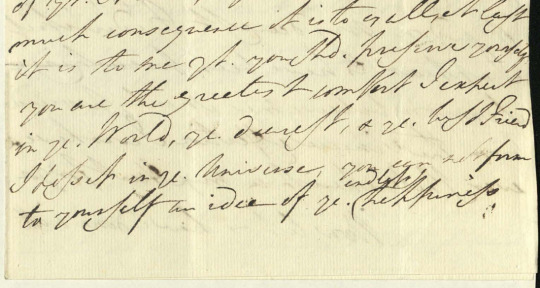

GEO/MAIN/43619-43620: George, Prince of Wales to Prince Frederick, November 7, 1783 (12/09/2022)
My dearest Frederick,
I am most excessively alarmed & terribly uneasy at understanding yt. you have again been seriously ill. For Haven’s sake, dearest brother, take care of yr. health, you know not of how much consequence it is to us all, at least it is to me, yt. you shd. preserve yourself. You are the greatest comfort I expect in ye. world, ye dearest & ye. best friend I possess in ye. universe. You cannot form to yourself an idea of ye. endless happiness I expect to enjoy again one day or another in your society, therefor let me once more entreat of you, for Haven’s sake, to take care of your constitution.
Although Frederick, Duke of York probably had the most iron constitution from among all his siblings, he too was afflicted by, sometimes very serious, bouts of ill health and some familiar disorders. These episodes of ill-health not only greatly alarmed his father but even more so his older brother, George, the Prince of Wales.
#prince frederick#frederick duke of york#prince george#prince of wales#letters#handwriting#1783#illness#the georgian papers programm#george iv#prinny#siblings#british history
16 notes
·
View notes
Text
MBBS in Georgia: A Gateway to Achieve Success in Medical Career
Georgia's medical universities are at the top of the rankings and have a positive reputation in the world of medical education. The greatest choice for Indian medical students is to pursue an MBBS in Georgia. Due to its 100% literacy rate, the nation is a popular choice for overseas students seeking to pursue an MBBS. The National Medical Commission has accredited the MBBS programmes in Georgia, allowing Indian medical graduates to continue their pursuit of a medical career in India. The MBBS programme in Georgia is the best choice for both male and female students seeking an affordable, top-notch medical education.
Depending on their lifestyle, overseas students enrolled in Georgia's MBBS programme pay between $260 and $300 per month for living expenses. The cost of an MBBS in Georgia is affordable not just for students from wealthy households but also for those from low-income backgrounds. It is the ideal location for affordable, top-notch medical research.
Why MBBS in Georgia?
Georgia's MBBS universities offer excellent educational programmes. Furthermore, Georgia is home to around eighteen medical universities that have received recognition from MCI, the WHO, and other medical organisations. Because of this, it's a fantastic substitute for Indian students who wish to pursue an MBBS overseas.
Georgia's medical universities are equipped with cutting-edge technology and first-rate facilities. Due to their early semester clinical clerkship and experimentation opportunities, students also gain practical experience in the actual world.
Students who wish to study MBBS in Georgia can apply in a straightforward manner. Universities in Georgia base their MBBS admissions decisions on a student's performance in the 12th grade physics, chemistry, and biology courses. Students can be admitted to Georgia's MBBS programme with a minimum of 50% in these disciplines.
Many Georgian medical schools provide affordable MBBS programmes for those who wish to pursue their studies overseas. International students can benefit from a 50% travel discount. This lowers their monthly expenses, which is a significant benefit for Indian students hoping to pursue an MBBS overseas.
Georgia is a very safe state for students, both male and female. They have extremely low crime rates since they are a developed nation. Students can use public transit with safety. Additionally, there are hostels specifically designated for men and women. The standard of living in Georgia is unrivalled.
In the third year of their MBBS programme abroad in Georgia, students can start the application process for permanent residency. Additionally, students might choose to pursue their post-graduation studies in Europe by relocating there.
Since English is the primary language of instruction at most colleges, studying MBBS in Georgia is an excellent choice for Indian students.
What is Georgia's FMGE passing percentage following MBBS?
Thousands of Indian youngsters aspire to become doctors and attend any accredited medical school abroad.
After earning a degree from another country, students who wish to practise medicine in India must register with the State Medical Council (SMC).
A candidate for a foreign medical qualification can only be added to SMC's registry after passing the FMGE (Foreign Medical Graduate Examination), which is administered by the National Board of Examinations.
FMGE is held in the months of June and December on two occasions annually.
To pass the test, a candidate must receive at least 50% of the possible points in each of the papers.
A candidate may attempt to pass the exam up to three times.
0 notes
Text
Georgia Medical School for Indian Students
The pattern of NEXT exam is broader than the existing NEET PG and it will thoroughly check clinical skills. Part one (NEXT 1) of this exam will be an objective MCQ-based paper, a rank which will decide your seat in the PG medical course and qualification for post-MBBS internship.
Georgia, a former Soviet republic located at the meeting point of Europe and Asia, is home to both Black Sea beaches and settlements in the Caucasus Mountains. Tbilisi is the capital and largest city of Georgia. Georgia has emerged as a top choice for Indian students looking to study medicine. A medical degree from Georgia is cost-effective because medical schools have reasonable tuition. Additionally, the National Medical Commission (NMC) and the World Health Organization accept Georgia's MBBS degree (WHO). Admission to Georgian universities is a fairly quick and straightforward process. In Georgia, Tbilisi is regarded as the ideal location for MBBS study because it has 100% literacy. Georgia is the fourth-safest country in the world, making it a safe place to live.
Georgia's MBBS program is quickly becoming one of the top alternatives for Indian students in various nations. Georgia provides students with a top-notch medical education for an astonishingly affordable tuition rate of $4000 to $8000. Georgian universities, on the other hand, provide traditional education at only acceptable course prices without an entrance exam.
Benefits of attending MBBS school in Georgia:
*A popular location for Indian students seeking to study medicine overseas
*There is no entrance exam for Georgia's MBBS programme.
*No donation is necessary
*Universities accredited by the National Medical Commission, listed under WDOMS, and recognised by the WHO (NMC).
*No TOEFL or IELTS prerequisites are necessary.
*100% English only
*Global recognition of Georgia's MBBS degree
*Superior education
eligibility requirements
Candidate must have completed their 10+2 (sr. secondary education) with at least 50% in PCB (physics, chemistry, and biology) from a board that is recognised. 17 years old should be the minimum age.
Admission: - Admission will be based on the results of the entrance examination (NEET).
*NEET Reduced score
*Documents needed for admission in Georgia, listed
*Original 10th Grade Report
*Original 12th Grade Report
*To be supplied through email is the original passport together with an accurate scan of the front and back.
*NEET Grade Report
*Photograph
digital image with a white backdrop and shoulder height is required. Your face should be in close-up, along with the tops of your shoulders, so that it occupies between 70% and 80% of the frame. (Please send a clean scan copy to the email address your counsellor has supplied.)need six passport-size photos should have a white backdrop and be 35mm x 45mm in width and height.
*Card Aadhar
*Copy of a student ID card (For Dollar exchange & Forex Card)
The NEXT MBBS question pattern of the National Exit Test paper- 1 exam is expected to be divided into three important parts. There will be a total of 540 multiple choice questions in the exam. 60% of questions will be to test problem-solving skills, 30% questions for comprehension & analysis, and 10% recall questions.
0 notes
Text
La Fayette in Prison - Addendum
Ever since I have started my “La Fayette in Prison” series, I have been frustrated by the lack of information. Something that irked me especially was the fact that most books/papers always wrote that La Fayette was initially arrested with his fellow officers, a few Aide-de-Camps and their servants - but I have never seen their names and is honestly is a shame that we do not know who most of these men were.
Just the other day, I was browsing the Georgian Papers Programme and found a letter that must have been added quite recently because I have seen it before during similar searches. It is a letter in French, written on August 29, 1792 by an unknown person and addressed to William Henry, Duke of Gloucester (younger brother of King George III). The letter relates intelligence gathered by a Mister Long from Liegne about the French Revolution. At the very end is a “Liste des officiers francais arrété à Rhochefort Le 21 aoust 1792” - in other words, we can now a least name some of the men that were arrested that day - and in no small parts thanks to the wonderful @acrossthewavesoftime who helped me decipher all of the names!


GEO/MAIN/54401-54402
Envoyé à M. Le Duc De Bourbon. Le Gen.’ Lafayette, Latour Maubourg,
alexandre Lameth, De Launoir, Maréchaux De Camp ‑ Victor Maubourg,
Colonel de chasseurs - Charles Maubourg officier; Lacombe aide de camp
Général-Mayor Cap.ne aide de camp ‑ Soubeyran Capitaine ‑ Gouvion
frere cadet Du tué ‑ lillet Commissaires des guerres - Les Deux
freres Thomeuf Capitaines de Dragons - Cadignan Lieutenant Colonel ‑
Curemaire Capitaine ‑ Bureau de pussy Capitaine Du Génie ‑ Beaucoup
d’autres qui ne sont pas De marque. ils avoient en tous pour eux et Leur
Domestiques 90 chevaux ./:
Some of the names on this list are pretty well known, both for the person individually but also for their involvement in the French Revolution and their subsequent arrest. La Fayette, the three Maubourg brothers, Lameth, Bureau de Pussy … but while many of these names are well known, just as many names are completely unknown, at least to me. This is one of the moments where you have to realize, that history forgets and history overshadows.
#lafayette in prison#lafayette#la fayette#marquis de lafayette#general lafayette#historical lafayette#french revolution#french history#british history#georgian papers programme#1792#letter#handwriting#william henry duke of gloucester#mr long#liegne#acrossthewavesoftime
15 notes
·
View notes
Link
“I am transported, my dear friend to understand that your friend is as much an unbeliever as to the rabbits as I am.”
So wrote Princess Caroline, wife of George, Prince of Wales (the soon-to-be George II) to her friend Mrs. Clayton, one of her Women of the Bedchamber, sometime in November or December 1726 (GEO/ADD/28/114). We don’t know who the friend the Princess is referencing, and perhaps that doesn’t matter. But what does she mean when she says she is “an unbeliever as to the rabbits”? Because the letter isn’t dated, we don’t know for sure, but it’s highly likely that she’s referring to an incident that went 18th-century-viral: Mary Toft, the woman who gave birth to rabbits.
#mary toft#18th century#1720s#georgian papers programme#georgian britian#british history#princess caroline#george ii#queen caroline#con artists#history of medicine
10 notes
·
View notes
Photo


An Audience for Hamilton’s George III, Michael Jibson, With King George III Himself: A Virtual Exhibition [x x]:
On 25 September 2018 Michael Jibson, the award-winning actor whose portrayal of King George III in the London staging of Hamilton is one of the highlights of the show, was invited to visit the Royal Library at Windsor Castle to see a selection of the remarkable collection of documents held by the Royal Archives that relate to King George III.
[. . .]
In Hamilton, King George III is seen only via and in context of the American Revolution. But through the work of the Georgian Papers Programme, we see the American Revolution as but one aspect of the king���s life and reign, and Britain’s empire.
In this exhibition created for Mike, we linked Hamilton’s and the programme’s perspectives by organising the exhibits around the themes highlighted in the three songs he/George sings in the show: ‘You’ll be back!’, ‘What comes next?’ and ‘I know him’, as well as the one crucial line which features in all three songs which speaks to our wider perspective: ‘Oceans rise, Empires Fall’.
Since Mike clearly found the documents he saw fascinating, the Programme team decided to make a virtual version of the exhibition available online, so that fans of both the show and of the actor could have the opportunity to tread digitally in Michael’s footsteps. You can see records of Michael’s visit itself here and here.
Michael Jibson’s visit forms part of a programme of events and initiatives designed to share the work of the Georgian Papers Programme with the widest possible public and to demonstrate the interest and relevance of its findings to audiences on both sides of the Atlantic. We are also interested in contemporary representations of the Georgian period and of King George III himself, and the visit was therefore also an exciting one for us, bringing as it did one of his foremost interpreters face to face with George’s own documents in his own home.
Hamilton represents a fresh new directions in music theatre, and has thrilled audiences on both sides of the Atlantic. Here this cutting-edge theatre comes together with one of the most historic sites in the United Kingdom: the round tower at Windsor, where the documents are stored in the Royal Archives, which dates from the twelfth century. King’s and the Omohundro Institute at William & Mary are not only distinguished centres of historical research and teaching, but also both also have strong historic royal connections, with the former being granted its royal charter by George III’s son George IV in 1829 (making it the fourth oldest university in England), and the latter being founded in pre-Revolutionary North America in 1693 by letters patent issued by William III and Queen Mary (making it the second oldest institution for Higher Education in the United States).
pay King George III a visit!
#hamilton#michael jibson#king george iii#history#british history#twitterico#georgian papers programme
68 notes
·
View notes
Photo
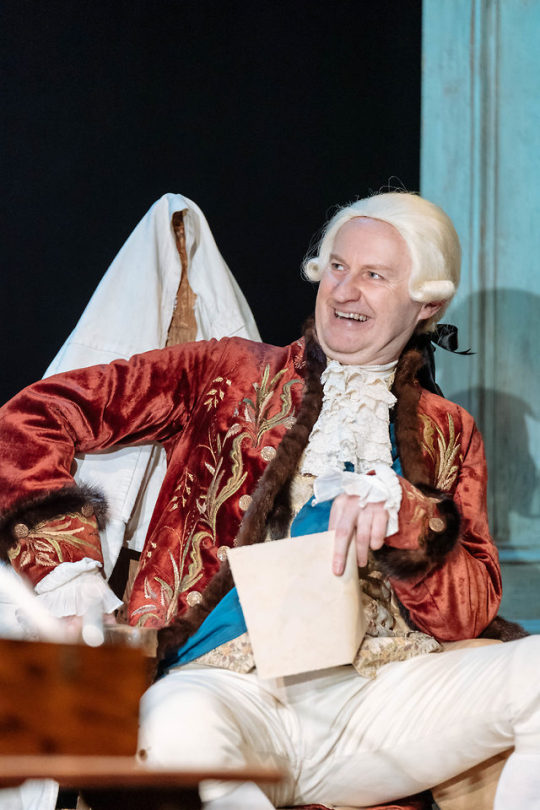

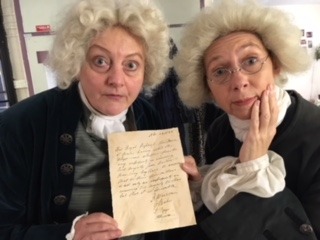

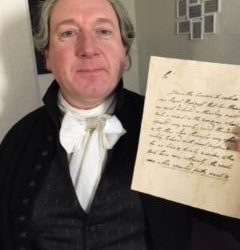
The 18th Century Materializes on Stage
#mark gatiss#the madness of george iii#georgian papers programme#Adrian Scarborough#Stephanie Jacob#Amanda Hadingue
9 notes
·
View notes
Note
Dearest Georgian Suggestions, Have you heard of the Georgian Paper's Programme? It's an online program attempting to transcribe an archive of documents from the Georgian period for academic use. Very recently it opened up transcriber status to anyone who wishes to participate. I believe that you might find it interesting, if you have not already heard of it!
Gentle Reader--
I had No Knowledge Whatever of this Venture Before you sent your Generous Message. What an Intriguing Project! I am Certain Interested and Industrious Readers with Time and Leisure to participate will find it Both a Diverting and Edifying Use of their Powers. (https://georgianpapers.com/)
Yours &tc.,
The Editor
80 notes
·
View notes
Link
17 notes
·
View notes
Text
Prince Edward learns how to Swim
Even royal Dukes like to swim in the sea and Prince Edward, later Duke of Kent, learned how to swim in the summer of 1780.
He wrote to his older Brother Prince William, later William IV, on July 28, 1780 to congratulate him on his approaching Birthday, his recovery from an illness and to tell William of his trip to the seaside. William was the only one of George III numerous children that joined the Royal Navy and Edward did not neglect to include all the fleet movements that he could observe while staying in Sussex. Below the cut is a complete transcript of the letter but I mainly wanted to focus on two paragraphs.
Edwards Birthday Wishes:
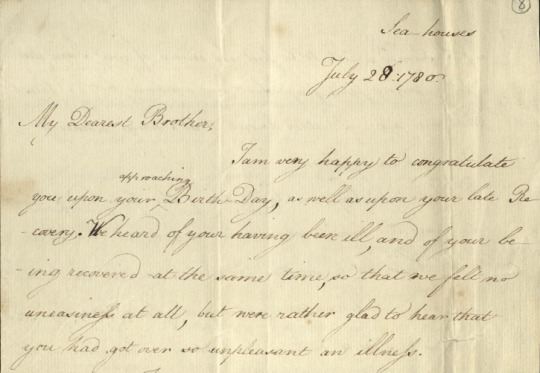
My Dearest Brother,
I am very happy to congratulate you upon your approaching [inserted] Birth Day, as well as upon your late Recovery. We heard of your having been ill, and of your being recovered at the time, so that we fell no uneasiness at all, but were rather glad to hear that you had got over so unpleasant an illness.
Edwards learning how to swim:

I am upon the coast of Sussex now together with my two Sisters Elizabeth, & Sophia, & my Brother Octavius, for the benefit of bathing in the Sea; at first I did not like it much, but now I am fond of it. I begin to attempt Swimming, & I hope to get some notions of it before I leave this Place.
I find it quite noteworthy that Edwards congratulate William beforehand on his Birthday (I have always been told that that would bring bad luck.) He writes this letter on July 28 and Williams Birthday was on August 21 … so Edward was quite a few days off. There is a possibility that he thought this would be his last chance to write before August 21, but I find that rather unlikely. Since the word “approaching” was clearly added later, I could imagine that Edward simply confused Williams Birthday. We should not forget that in July 1780, Queen Charlotte was pregnant with her fourteenth child. Edward therefor had to keep track of thirteen birthdays, many of them being quite close together.
Prince Edward to Prince William, July 28, 1780, GEO/ADD/4/204/8 (03/30/23)



My Dearest Brother,
I am very happy to congratulate you upon your approaching [inserted] Birth Day, as well as upon your late Recovery. We heard of your having been ill, and of your being recovered at the time, so that we fell no uneasiness at all, but were rather glad to hear that you had got over so unpleasant an illness.
I am upon the coast of Sussex now together with my two Sisters Elizabeth, & Sophia, & my Brother Octavius, for the benefit of bathing in the Sea; at first I did not like it much, but now I am fond of it. I begin to attempt Swimming, & I hope to get some notions of it before I leave this Place.
If I should want to be put in mind of you, I am daily so [inserted] by seeing fleets pass before my window, bit I trust that my dear Brother knows that I want nothing to remind me of him.
We have had Captain Cummins of the Carisford Frigate to guard the Coast between Dungenness and Beachy Head; but he quited the Station on the Last Day of June; Lieutenant Macdowgal of the Flying Irish Cutter was lately relived by Captain Fortescue of the Scourge Brig, and Lieutenant Bivet of the Surprize Cutter. These two vessels in Company with the Carisford took a very good prize, as they were coming here. You see that by his Majesty’s kind care we are not entirely left at the mercy of Privateers that might have come this way.
We have all received great benefits from sea bathing. I daresay that your letters from Windsor inform you that all our family is very well. I conclude, Dear Brother, with assuring you that success to the fleet & continuance of good health to you are the constant & sincere Wishes
Of your very affect. Brother
Edwards
P.S. Mr. Bruyeres desires me to make his best respects & most sincere good wishes for the return of many of your Birth Day in health, happiness & glory [inserted] acceptable to your Royal Highness.
Pray give my compliments to Mr. Majendie, Mr Bruyeres begs to join with me.
#prince edward#prince edward duke of kent#prince william#william iv#letters#handwriting#1780#mr buyeres#mr majendie#princess sophia#princess elizabeth#prince octavius#lieutenant bivet#captain cummins#royal navy#siblings#british royal family#british history#the georgian papers programm#george iii#queen charlotte
6 notes
·
View notes
Quote
'Whilst I was at W__, a gentleman came in & related the following anecdote - which perhaps had he known I was in the family he would not have done - "The Prince of Wales is a great Coxcomb in his dress - but he is particularly attentive to the appearance of his feet, & wears such tight shoes & large Buckles that the King has taken every method to make him leave them off without effect - I heard," said he, "that... the King took the Prince a remarkable long walk through Bogs, up Hills, over stones etc. the Prince's shoes burst at the sides & what with the weight of the buckles & the tightness of the shoes and the length of the walk his feet were covered with blisters, & he was quite lame - the King flattered himself he had gained his point, but the Prince's obstinacy was proof against his sufferings, & he appeared at Dinner, & ever since in tight shoes & large Buckles." This was a pretty sort of conversation for me to hear - I make no comments! So you like being marked out for a Coxcomb?’
From Mary Hamilton’s 1779 correspondence with the 16 year-old Prince of Wales (now available in the Royal Collection Archive as part of the Georgian Papers Programme)
#quote#george iv#this is just their relationship in a nutshell#but also haven't we all been that stupid fashion-conscious teen
7 notes
·
View notes
Text
Meet The Artists – Sarah McMenemy

London based Illustrator Sarah McMenemy has been with The Artworks for over 30 years! Joining the agency as one of our first ‘Startworks’ artists during her time at Brighton School of Art, Sarah is best known for her delicate use of ink and collage.
Sarah’s favourite project since joining The Artworks has been the series of mural illustration’s she created for Shadwell underground Station in London. Working with Transport for London, Sarah created a series of gorgeous Illustrations that reflect the surrounding area and explore the rich history of Shadwell.
We had a chance to chat to Sarah and find out more about her life as an artist…
Where do you live? Where is your studio located?
I’ve always lived in London, and the architecture, the colours, the people and visual stimulation of the city has had a strong influence on my work. As a teenager I used to draw the beautiful Georgian terraced houses of Hampstead and Highgate on commission. I am often asked to create images of the city, some of my favourite and most successful projects have been based here. I have a broad client base from the London Underground network to City law firms, and Publishers and have depicted many London pubs, restaurants and city institutions. This type of work has lead to a wide travel portfolio and I enjoy capturing the atmosphere of different destinations worldwide.
My studio is in the mean streets of De Beauvoir Town in Hackney. I work in a Victorian artisan studio. There are eight of us including architects, graphic designers and illustrators. Plus, a rather chunky studio cat.
Can you describe your creative process?
I’ve got a thing about paper – its physicality, the sometimes-unpredictable way paint behaves on it. I like creating abstract, graphic elements and rich textures through collage, paint and ink; combining fine line details with loose brush strokes and abstract shapes. The enjoyment of the physical process of making images is central to my work. It has an intrinsic optimistic and uplifting character giving it wide appeal across many areas of the industry.
What does a typical working day look like?
I usually go for a walk or a run before I get in to the studio, and I like to make sure everyone knows about it before getting on with my jobs. At lunchtime we sit down together to eat our overpriced but convenient sandwiches from the local deli.
I work through to the end of the day, sometimes into the evening if the deadline is tight. If I’m on my own, I may play some dance music. Come to think of it I may do that even when I’m not on my own. If there is a music god I think his name is probably Nile Rogers.
Do you listen to music or the radio whilst you work? If so, what’s on your playlist?
I like it when it rains as it makes a loud noise on the roof and I feel like we’re camping in a tent (aka UK camping). We generally listen to NTS, the local Dalston radio station. I also like 6Music, a bit of Radio 4, and sometimes Pop-master – yes, Radio 2.
How long have you been with the Artworks for? What drew you to Artworks?
I have been with the artworks since before I left college, only a few years ago now. Ok 33 years. I started in their Startworks group when they visited Brighton School of Art to give a talk, and we met when they looked around our studio in the lunch break. Actually, I missed their talk as I was shopping at Miss Selfridge but it doesn’t seem to have harmed my career much.
What books or programmes did you love as a child? Have they influenced your work in any way?
Books were a big influence on me as a child and there is certainly a flavour of them that comes through in my work now. Edward Ardizzone’s illustrations for Stig of the Dump and Jean and Gareth Adamson’s Topsy and Tim, Richard Scarry, Beatrix Potter, Shirley Hughes and Miroslav Sasek are a few that come to mind.
Loved all the Oliver Postgate children’s programmes Bagpuss, The Clangers, and Noggin the Nog. Mr Benn was endlessly fascinating. Trumpton, Camberwick Green and, of course, The Magic Roundabout.
If you weren’t an artist, what would you be instead?
If I wasn’t an illustrator I would be a Club DJ playing exclusively Funk and Disco.
What was the most important lesson your learned at Art School, if you went!
Art school taught me to interpret a brief in a way that I can enjoy and therefore do my best work. And that the fine art students are top of the pecking order, in their eyes (love them really)!
What inspires you the most to create?
I find inspiration in the big skies of the Norfolk coast, the gently rolling hills of Hertfordshire, as well as noticing beautiful colour and shape combinations in everyday life. The energy of cities, particularly Paris, New York, Tokyo, Venice, London. And of course a bit of studio cake helps.
Name three artists that you admire
I can’t name three. Here are eight. Some favourite artists are John Piper, Raoul Dufy, Abram Games, David Gentleman, Toulouse L’Autrec, Humphrey Ocean, Saul Steinberg, Saul Bass.
What kind of commissions do you enjoy the most?
I really enjoy collaborating with clients and other creative professionals. I enjoy seeing my work at large scale in public places. Writing and illustrating a variety of children’s and adult’s books. It is exciting to have my work animated. I also like working in branding, visualising architecture and interiors, book covers and editorial. I enjoy the thrill of working live, at conferences or events. Short deadlines, long deadlines, they’re all good.
What would your dream commission be?
Dream Commission would be a set of stamps depicting beautiful skies around the or the grand international hotels like Claridges, The Savoy, The Ritz.
Do you have any pets? If so, what and what are they called?
We have a studio cat who walks along the roof light above our desks. It’s always nice to hear the soft thud of his paws on the polycarbonate. Purposeful, like he knows where he’s going, but sometimes he just stops and has an altercation with another cat, or soaks up some sunlight.
What 5 things could you not live without?
I cannot live without houmous, my mini, trees, tea and 6music.
What is your very favourite meal?
Fish Pie and peas.
What do you like to do in your spare time?
Singing in a choir, dancing, walking, running, exhibitions.
What is your current dream travel destination?
Quite fancy Barbados at the moment, but Copenhagen, Seville and Northumberland are on my list.

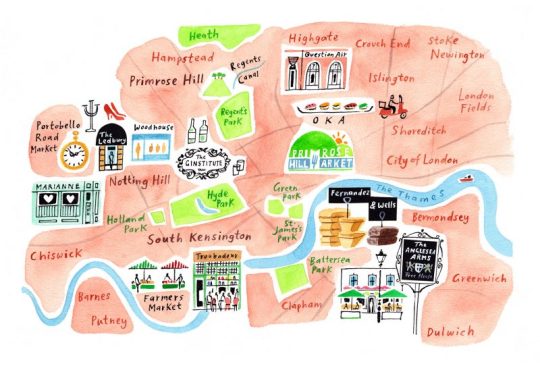


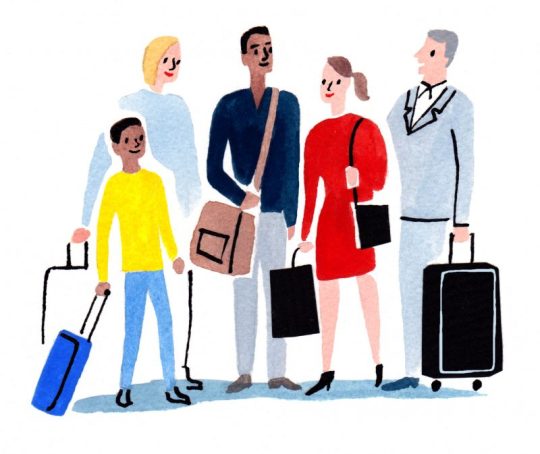

See more of Sarah’s work here.
1 note
·
View note
Text
Queen Charlotte on La Fayette
I was browsing more or less aimlessly through the digital achieve of the Georgian Papers Programme when I stumbled about an absolute treat (at least from my point of view). A letter that links two of the historic characters I am most interested in. The letter in question is a letter by Queen Charlotte, the Queen Consort of King George III to her oldest son George, the Prince of Wales (later George IV), dated August 26, 1792.
Queen Charlotte starts the letter to her “dearest son” with a few pleasantries, among them expressing her joy that he is in good health. On August 24, 1792, George had written her a letter informing her of the current state of affairs in France. Charlotte thanks him for the report and expresses her grief over the death of the Prince de Poix and the Princess de Lamballe … Charlotte then talks about the Marquis de La Fayette.

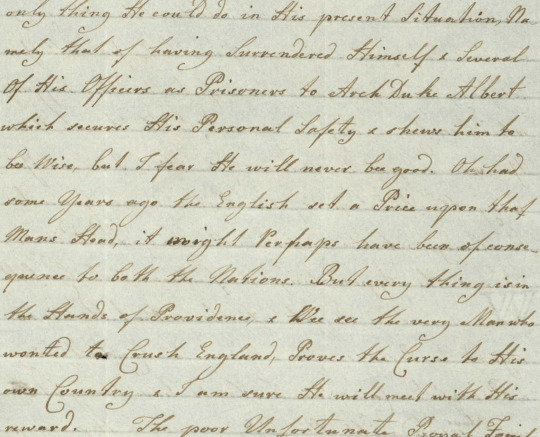
Monsieur de la Fayette is I believe quite safe out of their [the Assembly] Clutches by having done the only thing He could do in his present Situation, Namely that of having Surrendered Himself & Several of His Officers as Prisoners to Arch Duke Albert which secures His Personal Safety & shows him to bee wise, but I fear He will never bee good. Oh had some years ago the English set a Price upon that Mans Head, it might perhaps have been of consequence to both the Nations. But every thing is in the Hands of Providence, & We see the very Man who wanted to Crush England, Proves the Curse to His own Country & I am sure He will meet with His reward.
If you read very, very carefully between the lines you might detect, that Queen Charlotte was not the greatest admirer of the Marquis de La Fayette … but she expressed it in a really subtle way ….
#marquis de lafayette#lafayette#general lafayette#queen charlotte#george iii#george iv#prince of wales#prinny#1792#mother#son#letters#handwriting#princess lamballe#french history#french revolution#american history#american revolution#english#english history#english monarchy#queen#georgian papers programm#prince de poix
23 notes
·
View notes
Link
Among the challenging features of interpreting the king’s mental illness is getting a clearer picture of his family during his most acute episodes. In this letter of early December, 1788, when other evidence suggests the king was in such a terrible — and declining — state that within days a new doctor (Francis Willis) was called in to attend the case — the Queen writes to her eldest son, the king’s heir, that ‘the King is thank Heaven more Calm this afternoon’. This is a remarkably understatement. The king’s had only just been removed from Windsor to Kew, and his family essentially banished from interacting with him.
2 notes
·
View notes
Photo


Royal archives team up with Hamilton to teach the world about King George III (Telegraph) [x]:
When the Queen launched a project to open her enormous archive of papers from the reign of George III, it was hoped the letters, diaries and speeches would give the public an insight far beyond his reputation for madness. Now, those papers are to reach a whole new audience, as the Royal Archives form an unlikely alliance with a hit West End musical.
The actor who plays George III in Hamilton has been invited into the library at Windsor Castle to study key documents from the reign of the Queen’s great-great-great-great- grandfather, as academics hope to inspire others to learn more about the real king.
Those documents will now be made available digitally for the show's legions of fans, as researchers work to bring their "pieces of paper with old handwriting on" to a wider audience.
[. . .]
Academics working on the George III papers have now identified 20 documents out of around 350,000 Georgian papers which they believe give the clearest insight into the king, grouping them by theme and song lyrics.
The finished virtual exhibition, by the Royal Archives and King’s College London, and hosted by the Georgian Papers Programme website, includes George III’s family letters, a draft abdication speech, the advice passed to him by his father on how to be a good king and a hitherto unknown document recounting the Battle of Chesapeake Bay.
[. . .]
Oliver Urquhart Irvine, the Queen’s Librarian, said the project had come about thanks to a “passion about making this available to everybody at all levels”.
“Whether it’s for the most serious cutting-edge research or members of the public who enjoy going to a musical, archives are about stories and about people,” he said.
“It’s not about assuming that everyone is going to find an easy way into it [the papers], or find it at all. It’s pieces of paper with old handwriting on: it’s not immediately a given that it’s going to appeal to all audiences. “I think this has been a fantastic opportunity to show the depths and richness of the archive."
Asked whether the project was aimed at changing the public’s view of George III, he added: “I think what’s important is that we allow George III to emerge. We weren’t seeking to convey a particular view, but there is more to him than simply being mad or a farmer.
“We weren’t setting out to create any particular impression of who he was as a man, it’s simply that there is so much more to know about him.”
More information about the Georgian Papers Programme, as well as the Hamilton virtual exhibition, can be found at georgianpapersprogramme.com
34 notes
·
View notes